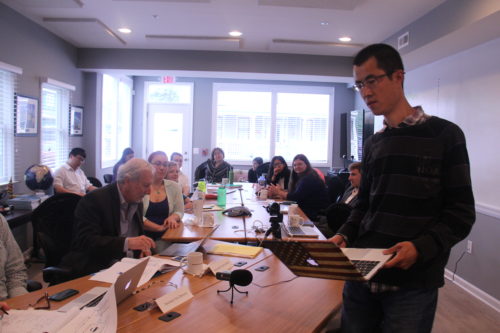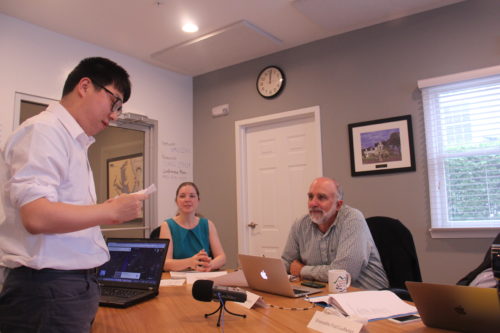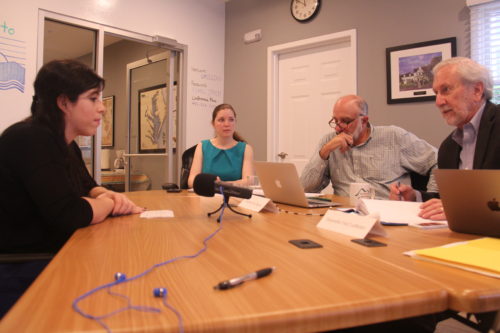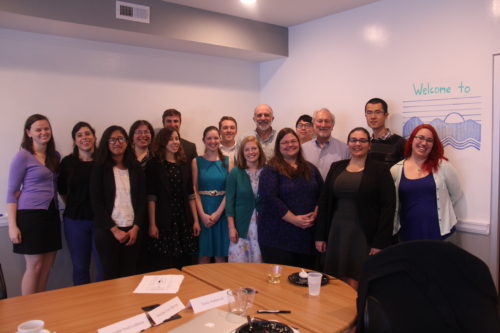How to give a good briefing
Hao Wang, Ana Sosa ·On Friday, May 5th, MEES students in the Science for Environmental Management class traveled from multiple campuses across the state to gather in Annapolis at the UMCES IAN office. For our last session of the course, we each gave an oral environmental science briefing that was related to a specific management topic of our choice. During the class we staged a simulated meeting: the students role-played as scientific experts, while the instructors, with their sufficient experience in reviewing environment management suggestions, played a panel of officials looking for environmental management recommendations. The panel consisted of the "Secretary of Environment," played by Don Boesch, the "Assistant Secretary of the Department of Natural Resources," played by Bill Dennison, and the "Governor's communication specialist," played by Suzi Spitzer. This exercise gave students an opportunity to showcase our understanding of topics in environmental management learned over the course of the semester, while also giving us experience in using various scientific communication techniques that we will need to master in our future careers.

So how do you give a good briefing? We will focus on that question in this blog.
The key to giving a successful briefing is to keep it accurate, concise, and clear. Although the content of the briefing may be similar to a public presentation or a speech, the format itself is different. Like other types of oral communication, a successful briefing focuses on the audience. While the information provided during a briefing is important, what’s more important is that the information stimulates a response from the panel. Here are some steps for giving a successful briefing:
1. Prepare
What is the formula for succeeding in professional settings? The formula, if there is such a thing, is sufficient preparedness. You must carefully prepare, both mentally and technically, in order to reach success. If you want to give a good briefing for a specific topic, thorough preparation is the first step to impressing and satisfying your audience. You should not only prepare the content, but also practice body language and the oral pacing of the briefing.
2. Dress formally
First impressions are not always correct, but they are especially important as the audience will judge you based on professional appearance. As a speaker, by dressing formally you show respect for your audience and also give off a look of confidence and competence. It is important to keep in mind that you also represent your employer and place of work, so you want to make them look good.

3. Introduce yourself
You should introduce yourself by sharing your name, your title, and the institute you come from. Based on this information, the panel will know some general information about you and your credibility as you give the briefing. After the introduction, most people will start to talk. Wait a minute, and do not forget to shake hands with the panel to show your confidence!
4. Give your talk
Give information in a clear, concise manner to emphasize your main point. Speak clearly and at an adequate volume, maintain positive body language, make eye contact with all audience members when speaking, and stay within your scheduled time frame.
Remember, a picture is worth a thousand words. Visual aids can dramatize, amplify, or clarify the points you are trying to express verbally, and can attract the panel members' interests. Whatever visual support you use, keep a few things in mind:
- Make sure your visuals are relevant, simple, and large enough to be seen by your audience.
- Don’t let your visuals draw your attention or the attention of the audience members away from your spoken message.
- Data tables are not recommended since audience members can get confused or distracted by too much data in front of them. Figures and charts are more straightforward.
Furthermore, keep in mind that the audience's background is likely very diverse and you should not use specific jargon since they may not have the same specialized vocabulary that you have, as the expert. If you really need to include complicated words, always provide a quick explanation, and remember that complicated concepts can often be explained in simple terms. For example, the word 'hypoxia' might be not easy to understand for panel members, so you could change the word to 'dead zone' or 'low oxygen' to increase the likelihood that your audience understands you.

5. Answer questions
After you give the briefing, the panel will ask you to answer some questions. Some questions could ask you to clarify what you already said during your talk so that the panel can listen again. Other questions could be specific follow-ups to the suggestions you raised during your briefing, and could ask for further information to support or defend your main point. For example, panel members might ask why you consider your recommendation or method to be better than alternatives. When answering questions, speak with assurance, keep answers brief, and don’t be evasive even in the face of a difficult or negative question. If you can’t adequately answer a question immediately, be honest and provide a time frame for providing the answer in the future- then follow up later. During our presentations, one important issue that was repeatedly raised by the panel was the question of funding- what is the budget for your proposed environmental management recommendation, and where will the money come from? Try to anticipate questions that you think are very likely to be asked, and prepare responses for them ahead of time.

In summary, when giving a briefing, start with a subject that is of interest to your audience, select core points that support your suggestions, and then add more material to help you communicate your points. Then, practice, practice, practice! In the briefing room, dress professionally, introduce yourself, and when you are talking, pay attention to possible body movement and eye contact, and address questions honestly and with finesse. Now you are ready to give a good briefing!

We give special thanks to Dr. Dennison and Dr. Boesch for this excellent course and also thanks to Suzi Spitzer for her teaching assistant work this semester.
Other references:
Lohrey, J. How to Give a Successful Briefing? Retrieved from http://smallbusiness.chron.com/give-successful-briefing-76837.html
Kline, J. A. (2007) How to Give Winning Briefings. Retrieved from http://www.klinespeak.com/pdf/Give%20Winning%20Briefings--Kline.pdf
Next Post > Chesapeake Bay report card released in Baltimore
Comments
-
Qiurui Zhu 9 years ago
Thanks for Hao's blog. I learned a lot from this blog. Thanks to Dr. Dennison and Dr. Boesch for this wonderful flipped class and Suzi's great organizing work this whole semester.
-
Kavya Pradhan 9 years ago
I thought it would be tough to condense everything we went through in class that day into a blog post and you did a great job Hao! These are key points that I will definitely keep in mind not just for a policy brief, but also for any kind of presentation or talk.
-
Hao Wang 9 years ago
I give my special thanks to Suzi to help me in this blog writing!
-
Jake Shaner 9 years ago
Don't think I've ever impressed anyone with professionalism, considering my usual day to day is either wearing a biker bandana and carrying knives through unsuspecting citizens' backyards on stranding calls or spraying pesticides on a desert island. Appreciate the compliment Hao! Good blog to end the class. Had a blast taking this class, great instruction and great discussions. Will see you all at some point I'm sure (possibly to sell you a car, according to Bill?).
-
Stephanie Barletta 9 years ago
Hao, this is such an excellent guideline and summary for what is probably the most intimidating aspect of what many of us will face as career scientists. You did an excellent job of distilling down the information overload into the essentials that will allow us to succeed at communicating and applying science!
-
Ginni La Rosa 9 years ago
Nicely written, Hao! I also learned a great deal about communication from this class, particularly from this briefing project. I especially have difficulty being concise in my writing and presentations. With my science training, I am used to having enough page space or talk time to cover a greater proportion of the material I have gone through in preparation. It was certainly a challenge to put hours of research into just two pages and four minutes of speaking, but it is a great skill to practice!
-
Hadley McIntosh 9 years ago
The advice provided here is applicable whether going into a briefing, a job interview, or other meeting where you are an expert in a particular topic. Thanks for collating them all in one place so we can come back and see them later!
-
Alterra Sanchez 9 years ago
This is great advice! I will probably look to this when interviewing or briefing, or just presentations in general.
Good luck everyone in your future endeavors!
-
Katie Martin 9 years ago
After talking about the importance of establishing credibility, I realized I should have said my institution and maybe given a short statement on my background. I loved how some people even went beyond this and created characters and really got into their roles. Great guide, Hao!

